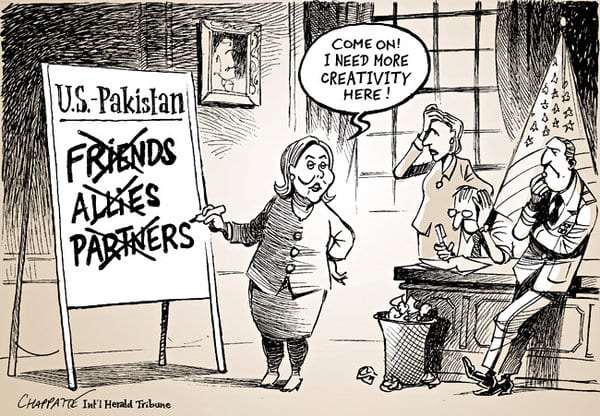
Image Source: “U.S. – Pakistan Relationship.” Chappatte Globe Cartoon, Chappatte in International Herald Tribune, 30 May 2012, www.chappatte.com/en/images/u-s-pakistan-relationship/.
Pakistan is the 7thlargest country in the world in terms of its population and a country that holds a negative view of the United States. The United States and Pakistan have been strategic allies on multiple occasions; however, the increasing distrust between the two countries due to conflict of national interests in the war on terror in Afghanistan has caused tensions in their pre-existing complex relationship.
The U.S. was among the first of nations to ally with Pakistan after its independence in 1947. The United States provided economic and social assistance to the newly independent country and still maintains vital military relations. In return, Pakistan proved to be a valuable strategic ally of the United States in the cold war against the Soviet Union and helped the U.S. in driving Soviet forces out of Afghanistan. Pakistan continues to hold a strategic position in the United States’ interests in the Central and South Asia region. However, unlike prior to 1980s where the relationship was based on mutual benefits and good will, the post 9/11 basis of partnership has been mainly transactional between the U.S. and Pakistani military, which is given aid by the U.S. to support its efforts in Afghanistan. This transactional relationship stemmed from a trust deficit caused by the both countries’ conflict of narratives as a result of their history regarding their national interests and motives in the region.
The growing perception of “Anti-Americanism” in Pakistan is primarily due to the U.S. security strategy concerns in Afghanistan and Pakistan that Pakistan feels undermine Pakistan’s efforts to fight terrorism, leaving the country feeling underappreciated by the U.S. This contributes to fostering a negative image of the United States in Pakistan. In current circumstances, with Pakistan being a strategic ally, the U.S. can use diplomacy in conjunction with public diplomacy to turn the tide in a relationship with Pakistan.
Currently, there is a decline in Pakistani public support of American cooperation with its military and for U.S. assistance and humanitarian aid in areas where extremist leaders operate. Also, there is less inclination towards the U.S. to continue providing intelligence and logistical support for Pakistani troops fighting extremism. Pakistanis feel that the U.S. doesn’t take Pakistan’s national interests into account and doesn’t give it sufficient credit for its contributions to the war in Afghanistan.
The U.S. led drone strikes are a major contributor to this sentiment. According to Pakistan, drone strikes targeting extremist leaders result in more collateral damage of civilians and are mostly carried out without the consent of the Pakistani government that threatens country’s sovereignty. Regardless of how the U.S. views drone strikes in North Waziristan area and how effective they are in targeting extremists, the collateral damage in form of civilian causalities and social structure raises questions about the outcomes of drone war on Pakistani soil. The unified objection of the unauthorized U.S. led drone strikes from the Pakistani government and the Pakistani military further fuels the Pakistani narrative that the U.S. only cares about pursuing its own objectives even at the cost of threatening country’s sovereignty.
To mitigate this major issue, the U.S. needs to work with the Pakistani government and its military on a new bilateral drone strikes strategy that considers both countries security concerns in mind so the major point of tension between them is resolved – the public diplomacy alone will not solve the problem. Despite of the U.S. and Pakistan history of distrust, consensus on drone strikes strategy may have a positive effect on their relationship. Once a consensus is reached, the U.S. can work with the Pakistani government to gain public support by communicating the drone attacks in a way that is transparent to the Pakistani public. The U.S. can also work with the Pakistani government to prevent civilian casualties or find/invest in alternatives to drone attacks such as Aware Girls to combat extremists, which instills a positive sense of perception in Pakistani public that the U.S. is not showing negligence in addressing their concerns. So far all the public diplomacy efforts made by the U.S. in Pakistan through bridging cultural gaps with programs like Fulbright Scholar Program and funding literacy education for underprivileged children or providing social and economic development opportunities to the private sector have been ineffective due to focus on the drone strikes. Mutual agreement of the countries on the use of drone strikes will pave the way for the better reception of the U.S. public diplomacy efforts in Pakistani public.
Over the years the relationship between the U.S. and Pakistan has been complex and ridden with distrust due to conflict of narratives regarding history and their roles in addressing security concerns in the region. The U.S. engagement in Pakistan is mostly highlighted in relations to the military, so every shift in that relationship affects the perception of the U.S. in Pakistani public. To counter the negative image building, the U.S. can use public diplomacy to mitigate Anti-Americanism caused by the U.S. foreign policies by reaching consensus on drone strikes with the Pakistani government and highlighting its role in social and economic development in Pakistan, thus signaling the desire for improving relationship to the Pakistani public.
Disclaimer: The opinions expressed in this blog are those of the author. They do not necessarily express the views of either The Institute of Public Diplomacy and Global Communication or The George Washington University.
